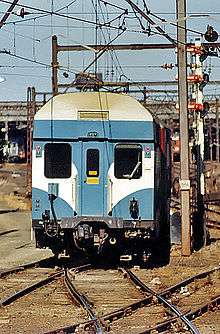Public Transport Commission
 Preserved Pressed Metal Corporation bodied Leyland Atlantean | |
| Commission overview | |
|---|---|
| Formed | 20 October 1972 |
| Preceding Commission |
|
| Dissolved | 30 June 1980 |
| Superseding agency | |
| Jurisdiction | New South Wales |
| Headquarters | Sydney |
| Minister responsible | |
| Key documents | |
The Public Transport Commission was an agency of the Government of New South Wales responsible for the provision of rail, bus and ferry services in New South Wales, Australia from October 1972 until June 1980.
Upon dissolution, responsibility for rail services transferred to the State Rail Authority and responsibility for bus and ferry services to the Urban Transit Authority.
The Commission, composed of five Commissioners appointed by the Governor of New South Wales, was accountable to the Minister for Transport.
Structure
The Commission was established pursuant to the Public Transport Commission Act 1972 (NSW) and led to the abolition of the offices of Commissioner for Railways and Commissioner for Public Transport.
The Act facilitated the merger of the Department of Railways and the Department of Government Transport,[1] the latter being the agency that operated government bus services in Sydney and Newcastle. From December 1974 ferries were added to its responsibility when the Sydney Harbour Transport Board was dissolved.[2] This coincided with government taking over the Port Jackson & Manly Steamship Company.[3]
In June 1980, the Public Transport Commission was dissolved with the State Rail Authority assuming responsibility for rail services and the Urban Transit Authority responsibility for bus and ferry services through the enactment of the Transport Authorities Act 1980 (NSW).[1]
Management
The Public Transport Commission consisted of five commissioners appointed by the Governor of New South Wales, two of whom were nominated by the Minister for Transport. Two of the Commissioners were full-time one of these was appointed by the Governor as Chief Commissioner. The Commission acquired the assets and liabilities of the former commissioners, were bound by current agreements or contracts, and were responsible for the completion of business commenced by them. The Commission inherited the functions of the previous Commissioners as prescribed in the Railways Act 1912 (NSW) and the Transport Act 1930 (NSW).[1]
The first Chief Commissioner of the Commission was Phillip Shirley, a former chairman of Cunard Line, who came out of retirement to take up the position. Shirley had been involved with the Beeching cuts being vice chairman of the British Railways Board in his native United Kingdom in the 1960s. His ruthless cost-cutting approach led to heated criticism from the public, trade unions and the parliamentary opposition, to the point where Shirley retired in 1975, two years before his commission was due to conclude. His successor, until the Commission was disbanded in 1980, was Alan Reiher. Reiher recognised that the Commission faced many problems that defied short-term solutions, the most chronic being the lack of modern passenger rolling stock. Upon the dissolution of the Public Transport Commission, Reiher became chairman of VicRail.[4]
Activities
The blue and white livery was introduced by Phillip Shirley with the two arrow NSW Sydney Transport logo being applied on buses, suburban electric trains and ferries while freight wagons were painted in a teal blue livery which Mr Shirley brought with him from his time at British Rail.[5][6] The trains and ferries would revert to their tuscan and green liveries in the 1980s.The two arrow NSW Sydney Transport logo was replaced by The L7 logo which was introduced in 1975. It would continue to be used, albeit with different colours, on buses and ferries until 1989 and on trains until 2010.
While best remembered as an era of cutbacks, investment was made during the tenure of the Public Transport Commission with the following ordered:
- 312 Leyland Leopard buses[5]
- 750 Mercedes-Benz O305 buses[5]
- 359 Comeng built S set double deck suburban carriages[7]
- 150 A Goninan & Co built S set double deck suburban carriages[7]
- 30 V set double deck interurban carriages[8]
- 10 FAM sleeper carriages
- 30 80 class diesel locomotives[9]
- 10 85 class electric locomotives[9]
- various modern bulk freight wagons
- More than 1000 RACE containers suitable for the Australia standard pallets
- 2 Lady class ferries (Street & Herron)
See also
References
- 1 2 3 "Public Transport Commission of New South Wales". State Records. Government of New South Wales. Retrieved 6 April 2012.
- ↑ Sydney Harbour Transport Board NSW State Records
- ↑ Andrews, Graeme (1994). Ferries of Sydney. Sydney: Sydney University Press. p. 76. ISBN 0 424 00202 7.
- ↑ Railway History in Victoria 1950 - now Australian Railway Historical Society Victorian Division
- 1 2 3 Travers, Greg (1982). From City to Suburb a Fifty Year Journey. Sydney: The Historic Commercial Vehicle Association.
- ↑ "20 Years Ago" Railway Digest November 1992 page 442
- 1 2 "EMU Review" Railway Digest March 1985
- ↑ "Rostering Electric Interurban Trains" Railway Digest January 1985
- 1 2 Oberg, Leon (2007). Locomotives of Australia 1854 to 2007. Dural: Rosenberg Publishing. ISBN 9781877058547.
| ||||||

